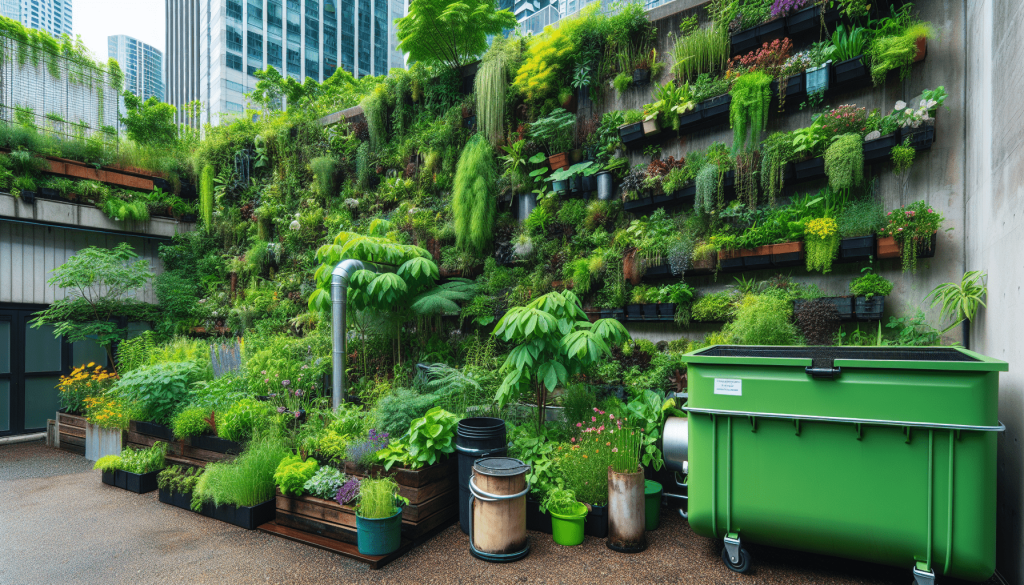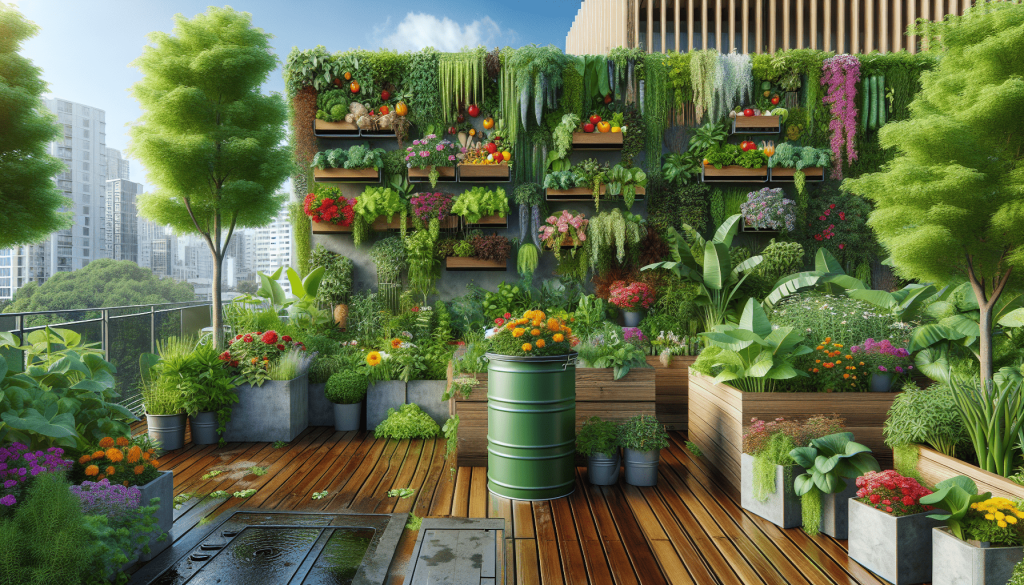This post may contain affiliate links. As an Amazon Associate, we may earn commissions from qualifying purchases.
Welcome! Discover how transforming your urban garden with permaculture principles can lead to a more sustainable and bountiful space. In “The Benefits of Utilizing Permaculture Principles in Urban Gardening,” you’ll learn how these methods maximize efficiency, conserve resources, and create a thriving ecosystem right in your backyard. Imagine harvesting fresh produce while supporting local wildlife and minimizing your environmental footprint. By integrating permaculture principles, you not only enhance the health and productivity of your garden but also contribute to a greener, more resilient urban environment. Dive in and unlock the potential of your urban garden! Have you ever wondered how you can turn your urban garden into a sustainable, thriving oasis? It might seem daunting, especially in a bustling city, but that’s where permaculture principles can come to the rescue. These principles offer a method to not only make your garden more eco-friendly but also incredibly productive.
The Historical Roots of Permaculture
Permaculture, coined from “permanent agriculture,” originated in the 1970s by Bill Mollison and David Holmgren. It was developed as a sustainable farming method that could meet human needs while preserving the environment. Initially focused on rural settings, permaculture has since found its way into urban contexts, providing city dwellers with a way to cultivate their green spaces responsibly.
Understanding Permaculture Principles
Before diving into the benefits, it’s important to understand the guiding principles of permaculture. These principles serve as a roadmap for sustainable gardening:
1. Observe and Interact
By taking time to observe your space and interact with its elements, you can create designs that suit its specific needs.
2. Catch and Store Energy
Make use of resources when they are abundant and store them for times of need. Solar panels, rainwater tanks, and compost bins are excellent examples.
3. Obtain a Yield
Design your garden to ensure it produces yields, whether it’s food, materials, or energy, to support sustainability.
4. Apply Self-Regulation and Accept Feedback
Ensure that your garden can regulate itself, reducing the need for external inputs. Listen to what your garden is telling you and adjust accordingly.
5. Use and Value Renewable Resources and Services
Reduce dependency on non-renewable resources by utilizing natural processes and materials.
6. Produce No Waste
Aim to make your garden a closed-loop system where waste is minimized. Composting and recycling are key strategies.
7. Design From Patterns to Details
Start with a big-picture approach, understanding broader patterns before focusing on specific details.
8. Integrate Rather Than Segregate
Combine elements in a way that they support each other. Companion planting is a prime example.
9. Use Small and Slow Solutions
Opt for smaller, incremental changes that are easier to maintain and less disruptive.
10. Use and Value Diversity
Diverse systems are more resilient. Diversity in plant species, bugs, and microorganisms can protect against widespread failures.
11. Use Edges and Value the Marginal
Utilize the spaces where different systems meet. These often-underutilized areas can be the most productive.
12. Creatively Use and Respond to Change
Be flexible and adapt your strategies as conditions change.
Having a grasp of these underlying principles helps you tailor your urban gardening efforts in a way that harnesses nature’s inherent processes.

The Benefits of Permaculture in Urban Gardening
Reducing Environmental Footprint
Urban gardens can help reduce your carbon footprint by providing local food sources and reducing waste. Utilizing rainwater catchment systems and composting organic waste minimizes your reliance on municipal utilities.
Creating a Micro-Climate
Urban spaces often face unique climate challenges, such as the urban heat island effect. By designing your garden with permaculture principles, you can create micro-climates that are more resilient to extreme weather. Trees, shrubs, and water features can moderate temperatures, making your garden more habitable year-round.
Increased Biodiversity
Diverse ecosystems are healthier and more resilient. Permaculture promotes biodiversity by encouraging the growth of various plant species. This diversity not only improves the health of the soil but also attracts beneficial insects and pollinators.
Resource Efficiency
Permaculture’s emphasis on using renewable resources and minimizing waste can significantly improve the efficiency of your urban garden. Water catchment systems, composting, and mulching are all techniques that conserve resources and enhance productivity.
Cost-Effectiveness
While the initial setup for a permaculture garden can be higher, the long-term savings are considerable. Reduced water bills, lower costs for fertilizers and pest control, and the free produce make permaculture an economically viable option.
Food Security
Growing your own food ensures a reliable supply of fresh produce, free from chemical pesticides and fertilizers. In uncertain times, having a garden that can sustain you and your family is invaluable.
Community Building
Urban gardening can foster a sense of community. Shared gardens and communal spaces become places for neighbors to come together, exchange knowledge, and support one another.
Practical Steps to Implement Permaculture in Urban Settings
Assess Your Space
First, evaluate the space you have. Whether it’s a small balcony, a rooftop, or a backyard, understanding your space is crucial. Observe sunlight patterns, wind directions, and soil conditions. This helps you design a garden that maximizes your available resources.
Soil Improvement
Urban soils are often compacted and low in nutrients. Improve your soil by adding organic matter, such as compost or aged manure. This enhances soil structure, provides nutrients, and improves water retention.
Water Management
Efficient water use is critical in urban gardening. Install rain barrels to capture and store rainwater. Use mulch to conserve soil moisture and reduce evaporation. Implementing drip irrigation systems can also minimize water use while ensuring your plants get adequate moisture.
Vertical Gardening
Limited space doesn’t have to limit your garden. Vertical gardening uses walls, trellises, and stacked containers to maximize space. Climbing plants like beans, peas, and vines can thrive in vertical setups.
Companion Planting
Companion planting leverages the beneficial interactions between different plant species. For instance, growing basil alongside tomatoes can improve tomato flavor and deter pests. Look for complementary plant pairings to boost your garden’s health and productivity.
Composting
Turn kitchen scraps and yard waste into rich compost. This not only recycles waste but also provides valuable nutrients for your plants. Compost bins come in various sizes, suitable for different urban settings.
Pollinator-Friendly Plants
Incorporate plants that attract pollinators like bees, butterflies, and hummingbirds. Flowers such as marigolds, lavender, and sunflowers enhance biodiversity and improve pollination rates.
Pest Management
Maintain a balanced ecosystem by encouraging beneficial insects and using natural pest control methods. Ladybugs, for instance, can keep aphids in check. Avoid chemical pesticides that can harm beneficial species and disrupt the ecosystem.

Common Challenges and How to Overcome Them
Limited Space
Urban environments often lack large gardening areas. Overcome this by using containers, hanging planters, and vertical gardens. Community garden plots can also provide additional space.
Poor Soil Quality
Urban soil can be contaminated or low in nutrients. Use raised beds filled with quality soil and organic matter. Regularly test your soil and amend it as needed.
Water Scarcity
Watering restrictions can pose a challenge. Collect rainwater and use efficient irrigation methods. Drought-tolerant plants and xeriscaping can also reduce water needs.
Light Constraints
Tall buildings and limited outdoor space can mean less sunlight. Choose plants that thrive in low-light conditions or use reflective surfaces to increase light exposure.
Case Studies of Successful Urban Permaculture Gardens
The Brooklyn Grange, New York
Located on two rooftops in Brooklyn, The Brooklyn Grange is the world’s largest rooftop soil farm. It produces over 50,000 pounds of organically-cultivated produce each year while promoting sustainable urban living. The farm uses composting, beekeeping, and rainwater harvesting, providing a model of how permaculture principles can be adapted to urban spaces.
City Garden, Melbourne
This community garden in Melbourne incorporates permaculture principles to transform a vacant lot into a productive green space. Utilizing raised beds, composting, and companion planting, the garden fosters community engagement and provides fresh produce to local residents.
Future of Urban Permaculture
As cities grow and the environment faces increasing pressures, permaculture in urban settings will become more crucial. Innovations such as aquaponics and vertical farms can integrate permaculture principles into urban architecture, reshaping how we think about city living and sustainability.
Conclusion
Utilizing permaculture principles in urban gardening not only makes your garden more sustainable and productive but also contributes to a healthier, more resilient urban environment. Whether you’re growing a few herbs on your windowsill or managing a larger community garden, the principles of permaculture can guide you in creating a thriving, eco-friendly space. So, why not take the first step today and begin transforming your urban garden into a model of sustainability? Happy gardening!








